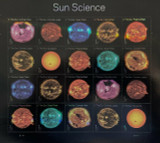THE BALLET SCORE THAT STARTED A RIOT!
A ballet about racial injustice? Economic inequities? No. It was the groundbreaking, actually earth shattering score of Igor Stavinksy that premiered Théâtre des Champs-Elysées in Paris on May 29, 1913. It has been described as the "trailblazing score that was the most influential musical work of its time."
While the Parisian audience may have been prepared for a modern ballet since Stravinksy had already achieved acclaim for this his ballet scores "The Firebird" and "Pétrouchka", yet The Rite of Spring's score’s completely fresh and revolutionary rhythms, structure, instrumentation and harmonies surpassed their wildest expectations. Basically, every facet of the score was treated in an entirely new way. Similarly, the dancing did the music justice in its strange contradiction of ballet technique and innovative costumes.
As the curtain went up and the opening notes were heard, a ruckus broke out in the auditorium. The opening bassoon solo was set so high that the audience didn’t know what instrument they were hearing. As dancers stomped to the initial primal rhythms, the audience began yelling, and a wilder and wilder shouting match began. It became difficult to hear the music.
The audience was reacting to a revolution.The Rite of Spring redefined 20th-century music, much as Beethoven's Eroica had transformed music a century before. With it, Stravinsky took himself far into the realm of the unconscious. The music seemed designed with no apparent order but driven by pure gut feeling.
The Rite of Spring may not be as shocking today as it was at that scandalous premiere in 1913, but more than 90 years later, it still has that edgy, intense, almost out-of-control feeling that makes it as exhilarating—and liberating—as music can be.
Collectors of French stamps can display in their collections stamps of the some of the giants of cultural innovation that have shaped the arts in the 20th Century. Composers and musicians include: Jules Massenet, Beethoven, Paul Dukas, Cesar Franck, Arthur Honegger
Artists include: Toulouse-Lautrec, Georges de La Tour, Jean Lurcat, Henri Rousseau, Jean Dominique Ingres, Georges Serat, Edgar Degas, and Claude Monet.
Recent Posts
-
SOLAR ECLIPSE, SUN WORSHIPPERS, AND MORE!!!
Last week's solar eclipse over a large portion of North America, aroused the curiosity of not just a …Apr 12th 2024 -
USPS FOCUS ON SHARK EDUCATION AND PRESERVATION
The United States Postal Service (USPS) has commemorated the fascinating world of sharks through a s …Apr 5th 2024 -
REPRINTING THE MOST SOUGHT AFTER US ERROR! THE INVERTED JENNY
The original Inverted Jenny stamp, issued in 1918, was meant to depict a Curtiss JN-4H biplane used …Mar 20th 2024





